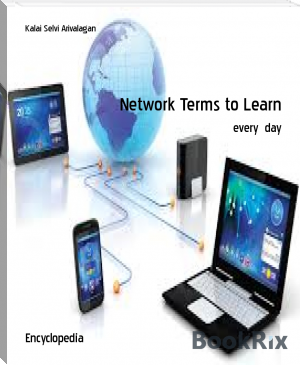Network Terms to Learn by Kalai Selvi Arivalagan (short books to read txt) 📖

- Author: Kalai Selvi Arivalagan
Book online «Network Terms to Learn by Kalai Selvi Arivalagan (short books to read txt) 📖». Author Kalai Selvi Arivalagan
Artificial Intelligence (AI)
Artificial intelligence (AI), also known as machine intelligence, is a branch of computer science that focuses on building and managing technology that can learn to autonomously make decisions and carry out actions on behalf of a human being. AI is not a single technology. It is an umbrella term that includes any type of software or hardware component that supports machine learning, computer vision, natural language understanding (NLU) and natural language processing (NLP).
Today’s AI uses conventional CMOS hardware and the same basic algorithmic functions that drive traditional software. Future generations of AI are expected to inspire new types of brain-inspired circuits and architectures that can make data-driven decisions faster and more accurately than a human being can.
AI initiatives are often talked about in terms of their belonging to one of four categories:
Reactive AI relies on real-time data to make decisions. Limited Memory AI relies on stored data to make decisions. Theory of Mind AI can consider subjective elements such as user intent when making decisions. Self-Aware AI possesses a human-like consciousness that is capable of independently setting goals and using data to decide the best way to achieve an objective. A good way to visualize these distinctions is to imagine AI as a professional poker player. A reactive player bases all decisions on the current hand in play, while a limited memory player will consider their own and other player’s past decisions. A Theory of Mind player factors in other player's behavioral cues and finally, a self-aware professional AI player stops to consider if playing poker to make a living is really the best use of their time and effort.
Term of the day - 27
BigQuery
BigQuery is a web service from Google that is used for handling or analyzing big data. It is part of the Google Cloud Platform. As a NoOps (no operations) data analytics service, BigQuery offers users the ability to manage data using fast SQL-like queries for real-time analysis.
Artificial Immune System
An artificial immune system is a system that utilizes some of the engineering of biological immune systems to put together algorithms or technologies that address systemic goals. This may involve mathematical and computer modeling of immune systems, or the abstraction of some immunology-related principles into algorithms.
Geotagging
Geotagging is the process of adding geographical information to various media in the form of metadata. The data usually consists of coordinates like latitude and longitude, but may even include bearing, altitude, distance and place names. Geotagging is most commonly used for photographs and can help people get a lot of specific information about where the picture was taken or the exact location of a friend who logged on to a service.
Data Smog
Data smog refers to an overwhelming amount of data and information - often obtained through an internet search - whose volume serves more to confuse the user than illuminate a topic. Data smog is a term coined from a book written by the journalist David Shenk, which deals with the influence of the information technology revolution and how the vast amount of information available online make it increasingly difficult to separate facts from fiction.
ARM Server
An ARM server, or Advanced RISC Machine server, is a server that uses ARM processors or chips instead of traditional x86 class processors. This allows the server structure to produce specific results with less energy waste.
Dark Mode
"Dark mode" in IT refers to user interfaces that work to decrease light output by changing the way that information is presented on the screen. Specifically, IT pros use the term "dark mode" to talk about light text showing up on a dark screen background.
Computational Storage
Computational storage is an IT design architecture where data is processed at the storage level. Computational storage allows for the merging of computing and storage resources for efficiency and complementary function.
Geospatial Mashups
Geospatial mashups are digital tools that bring data together from diverse sources and present them visually. IT Experts describe a geospatial mashup as a dashboard-like view or a similar visual tool.
Gesture Recognition
Gesture recognition refers to the mathematical interpretation of human motions using a computing device. It is a component of perceptual user interface (PUI). Other popular PUI components are voice recognition, facial recognition, lip movement recognition and eye tracking. Gestures could possibly come from any state or bodily motion; however, they usually originate from the hands or face. At present, gesture recognition is mainly centered on hand-gesture recognition and facial emotion recognition. In gesture recognition, the human body's motions are read by a camera and the captured data is sent to a computer. The computer then makes use of this data as input to handle applications or devices. Gesture recognition may also be referred to as gesture control.
Data Science Platform
A data science platform is an environment for conducting data science work, which typically includes coding and the deployment of code models, as well as the aggregation and use of data from diverse sources. Data science projects benefit from a central data science platform that is often described as a "software hub" for this kind of big data work.
Matplotlib
Matplotlib is a plotting library available for the Python programming language as a component of NumPy, a big data numerical handling resource. Matplotlib uses an object oriented API to embed plots in Python applications.
Vampire Tap
A vampire tap is a device that connects 10BASE5 cabling to Ethernet transceivers. The vampire tap gets its name from the way it taps into a cable. It pierces or bites through the insulation of the cable instead of slicing both ends to attach connectors. To connect the cable to the transceiver, a hole is drilled through the outer shielding. A spike is then forced through the hole to contact the inner conductor while other spikes are clamped onto the outer conductor. A small cable or attachment unit interface (AUI) is then connected from the vampire tap to the network interface card (NIC) in the computer.
Octet
An octet is a series of 8 bits. It is an important 8-bit designation that has played a significant role in the development of the personal computer (PC) and other hardware devices.
Accumulator
As a type of traditional register, an accumulator is a design within a CPU core that holds "intermediate" results. While a computer or device is working on multi-step operations, intermediate values are sent to the accumulator and then overwritten as needed.
Data Mart
A data mart is a subject-oriented archive that stores data and uses the retrieved set of information to assist and support the requirements involved within a particular business function or department. Data marts exist within a single organizational data warehouse repository. Data marts improve end-user response time by allowing users to have access to the specific type of data they need to view most often by providing the data in a way that supports the collective view of a group of users.
Bioinformatics
Bioinformatics refers to the use of computer science, statistical modelling and algorithmic processing to understand biological data. Bioinformatics is an example of how computer science has revolutionized other fields.
Master Data Management
Master data management (MDM) is the management of specific key data assets for a business or enterprise. MDM is part of data management as a whole, but is generally focused on the handling of higher level data elements, such as broader identity classifications of people, things, places and concepts.
Value Learning Problem
The value learning problem is a specific fundamental issue in the development of machine learning and artificial intelligence technologies that addresses the difference between humans and computers, and the ways that they think. In a nutshell, the value learning problem is based on how hard it is for computers to figure out what to "value" (in terms of both data and policy) and how to act in a machine learning network, and how programmers can optimize how the program acts to match their original intentions when they created it.
Quantum decoherence
Quantum decoherence in physics and quantum computing is the loss of quantum coherence. Quantum coherence is the idea that an individual particle or object has wave functions that can be split into two separate waves.When the waves operate together in a coherent way, that's referred to as quantum coherence.
Ambient Backscatter
Ambient backscatter is a new idea related to the use of radio waves and connectivity that posits a device's ability to send and receive signals without inherent power. It has the potential to greatly redefine the Internet of Things (IoT) landscape and change wireless technology in a big way.
Management Reporting
Management reporting is a key term for a type of business intelligence that involves reports meant to help managers to oversee operations and performance. These types of reports are core pieces of many new enterprise technologies that aim to automate or enhance the process of management reporting.
Advanced Analytics
Advanced analytics refers to a broad range of analytics that are intended to give businesses greater insight into their data than they could ordinarily. Some of these techniques include machine learning, data mining, predictive analytics, location analytics, big data analytics and location intelligence. A number of companies offer software packages that perform advanced analytics.
Control Structure
A control structure is a codebase portion that supports decisions based on analysis of variables. These functional components are eminently useful in computer science and computer programming.
Apache Avro
Apache Avro is a data serialization and remote procedure call framework which is developed within the Apache Hadoop project where it provides both a serialization format to get persistent data and a wire format for providing communication between Hadoop nodes, as well as connecting client programs to the Hadoop services. Avro uses the JSON format for defining protocols and data types, as well as serializes data into a compact binary format.
Delta Rule
The Delta rule in machine learning and neural network environments is a specific type of backpropagation that helps to refine connectionist ML/AI networks, making connections between inputs and outputs with layers of artificial neurons. The Delta rule is also known as the Delta learning rule.
Intelligence Amplification (IA)
Intelligence amplification (IA) is the idea that technologies can be assistive to human intelligence, rather than being composed of technologies that create an independent artificial intelligence. Intelligence amplification systems work to enhance a human's own intelligence, to improve a human decision-maker’s function or capability in some way. Intelligence amplification is also known as assistive intelligence, augmented intelligence, cognitive augmentation or machine-augmented intelligence.
Web Development
Web development refers in general to the tasks associated with developing websites for hosting via intranet or internet. The web development process includes web design, web content development, client-side/server-side scripting and network security configuration, among other tasks. In a broader sense, web development encompasses all the actions, updates, and operations required to build, maintain and manage a website to ensure its performance, user experience, and speed are optimal.
It might also, but not necessarily, include all those strategic actions needed to ensure its proper ranking on search engine results. Usually, those tasks pertain to a different specialization, namely search engine optimization (SEO). Web development is also known as website development, while the professionals that maintain a website are called web developers or (more commonly) web devs.
Software-Defined Networking (SDN)
Software-defined networking (SDN) is a newly emerging computer networking architecture. Its main distinguishing factor is the separation of the data plane from the control plane in routers and switches. In other words, the control is





Comments (0)